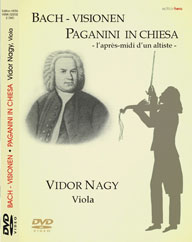BACH-VISIONEN, PAGANINI IN CHIESA – L’APRES-MIDI D’UN ALTISTE
Vidor Nagy (viola)
EDITION HERA 02202. (2 DVDS).
This DVD’s multi-lingual title is glossed upon in booklet notes that are almost as demanding for the reader as the music is for the performer, calling as they do Llpon Umberto Eco, Oscar Wilde and Stanley Kubrick.
Watching the DVD is no light fare either: three takes on the Bach Chaconne are followed by the Adagio and Fugue from the third Violin Sonata, and after that come twelve Paganini caprices. The performances were filmed in a beautiful Hungarian village church, the acoustics of which determined tempos that are slightly slower than Vidor Nagy’s studio recordings of the Bach pieces (Cadenza). They never feel it, though: Nagy just spontaneously relishes and takes his time over this or that transition. The performances are overwhelming; Nagy knows exactly where the music is going, and technical problems don’t seem to exist for him.
On the second DVD, having cannily chosen those caprices that can best be made to sound well on the viola, Nagy takes Paganini’s various kinds of gettato, pichettato and staccato galantly in his stride, as he does the runs in thirds, tenths and fingered octaves, never compromising his nicely nut-browne tone.
The performances – apparently unedited, as the odd less-than-perfect chord indicates – where recorded in just two days, further demonstrating that Nagy, who officially retired a few years ago, is playing better than ever.
CARLOS MARIA SOLARE, THE STRAD Januar 2011
Der mehrsprachige Titel dieser DVD wird in Booklet-Notizen erklärt, die für den Leser ebenso anspruchsvoll sind als es die Musik für den Interpreten ist, und sie nehmen dabei Umberto Eco, Oscar Wilde und Stanley Kubrick in Anspruch.
Die Besprechung dieser DVD ist ebenfalls keine leichte Sache: Auf drei Aufnahmen von Bachs Chaconne folgen Adagio und Fuge aus der dritten Violin-Sonate, und danach kommen zwölf Paganini-Capricen. Gefilmt wurden die Aufführungen in einer herrlichen ungarischen Dorfkirche; deren Akustik bestimmte die Tempi, die etwas langsamer sind als Vidor Nagys Studioaufnahmen der Bach-Stücke (Cadenzas). Doch bemerkt man es nie: Nagy genießt es spontan und nimmt sich Zeit für diesen oder jenen Übergang. Die Aufführungen sind überwältigend: Nagy weiß genau, wohin die Musik führt, und technische Probleme scheinen für ihn nicht zu existieren.
Für die zweite DVD hat Nagy umsichtig genau jene Capricen ausgewählt, die am besten auf der Viola zum Klingen gebracht werden können. Nagy wird mit Paganinis verschiedenen Arten des Gettatos, des Pichettatos und Staccatos ebenso elegant fertig, wie mit den Terz- und Dezimläufen und den Fingersatz-Oktaven, ohne je seinen schönen dunklen Ton zu beeinträchtigen.
Die Aufnahmen sind offenbar unbearbeitet, wie der eine oder andere nicht ganz so perfekte Akkord vermuten lässt; sie wurden gerade mal in zwei Tagen aufgenommen, was einmal mehr beweist, dass Nagy – offiziell seit einigen Jahren im „Ruhestand“ – besser den je spielt.

